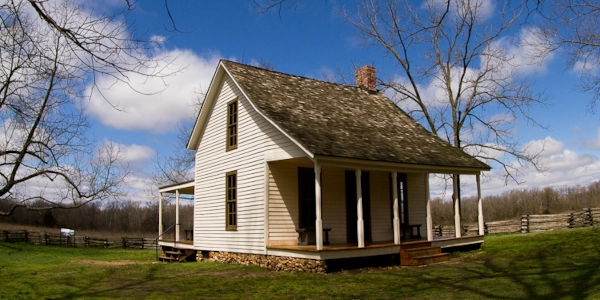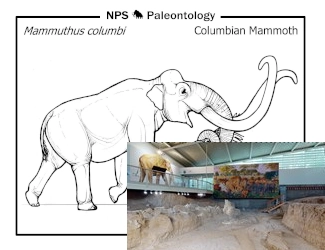
Image above: Background drawing of a Columbian Mammoth with inset bottom right of the dig site within the National Monument. Courtesy National Park Service.
Spotlight on Lesser Known History
Waco Mammoth National Monument, Texas
America's Best History Spotlight
On this page we're going to Spotlight the lesser known historic sites and attractions that dot the history landscape across the USA and are worth a visit if you're in their area. And while they may be lesser known, some are very unique, and will be that rare find. You'll be, at times, on the ground floor, or maybe even know something others don't. It'll be fun. Visit them.
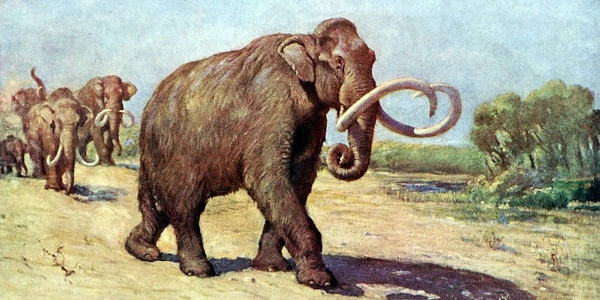
Waco Mammoth National Monument, Texas
Still a relatively new site, designated a national monument by President Obama on July 10, 2015, but the significance of its finding from a paleontological standpoint is huge. Twenty-four Columbian Mammoths have been discovered in this area around Waco, Texas. Yes, Waco has other history, bad, and good; Dr. Pepper was invented there. But for this site, you'll be witness to the actual dig areas where the mammmoths are still being found. And if you've got kids, this may be as close as you can get to a real dinosaur discovery, mammoth style. Image above: Drawing of the Columbian Mammoth, 1909, Charles R. Knight. Courtesy Wikipedia Commons.
Sponsor this page for $100 per year. Your banner or text ad can fill the space above.
Click here to Sponsor the page and how to reserve your ad.
Info, What's There Now, History Nearby
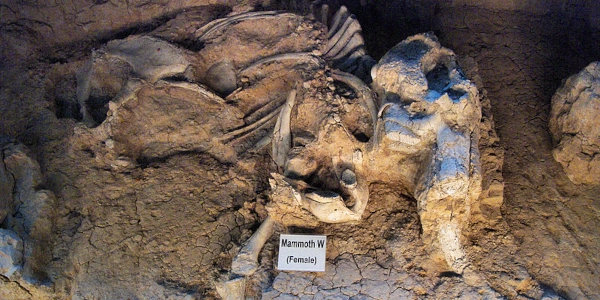
Waco Mammoth NM, Texas
Yes, during the Ice Age, a family herd of Columbian Mammoths roamed these Texas woods of oak, mesquite and cedar, and plains of tall grass prairie. Today, you can visit one of the only open dig sites that will show you the breath and huge size of the prehistoric creatures outside of a museum setting. A male mammoth would have stood up to fourteen feet high. Twenty-four adults and juvenile Columbian mammoths have been found at this site.
Image above: The dig site of the female Columbian Mammoth still being unearthed inside the dig tent, 2013, Larry D. Moore. Courtesy Wikipedia Commons, license CC BY-SA 3.0. Below: Remains of a Bull Mammoth Q and two juveniles. T & R. Juvenile T was buried 68,000 years ago, 2013, Larry D. Moore. Courtesy Wikipedia Commons, license CC BY-SA 3.0.
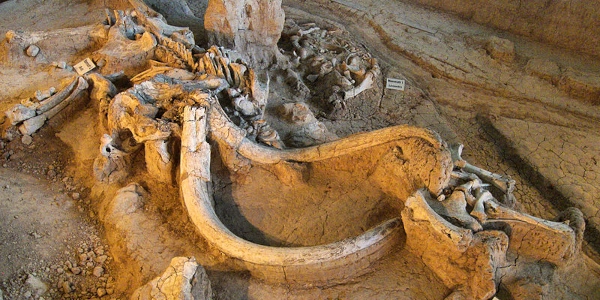
Where Is It
Waco Mammoth National Monument is located at 6220 Steinbeck Bend Drive, Waco, TX 76708. Waco itself is located in the north-central section of the state, one hundred and eight-five miles northwest of Houston, and just under one hundred miles south of the Dallas/Ft. Worth area.
What is There Now
Waco Mammoth National Monument
At Waco Mammoth, you can expect to see the Dig Shelter, but first stop in the Welcome Center to get orientation, a guided tour, exhibits, and tickets to the tour. There is a picnic area and amphitheater on grounds, about one hundred acres, and if you want to just take a walk, the Bosque River is at its southernmost border.
When Open and How Much
The monument is open daily from 9:00 to 5:00 with all areas free except visiting inside the Dig Shelter which incurs a separate fee. $5 adults; $4 students 7th grade through college, $3 students younger than 7th grade. Other discounts apply.
Fees subject to change.
Websites
Waco Mammoth National Monument
History Nearby
It's wide open Texas, home to sites about the Texas Revolution at the Alamo, San Jacinto, or the Battle of Goliad, its other missions, open spaces like Big Bend, Lake Roosevelt, and Big Thicket, and the Spindletop oil discovery. Whatever your brand of tourism or history is about, you're bound to find it in the state. But be warned, the state is so large, some of them are pretty far away from each other.
Buy Chronology

Great Book for the History Fan with Fifty Short Essays Telling the Story of American History.
Photos, History, and More Spotlights
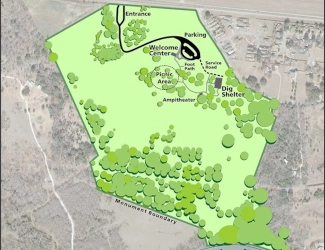
Discovery
It's gonna come as a surprise, it was to us, that the discovery of Mammoth remains at this Waco site only occurred in 1978. The concentration of these animals in one location had to do with flash floods, the first capturing a herd of nineteen mammoths around 65-70,000 years ago when the Bosque River rose rapidly. There would be three total flash floods that captured the mammoths and other animals at three different periods of time.
Paul Barron and Eddie Bufkin were looking for arrowheads in Spring 1978, and found, instead, a large bone inside a ravine. They removed it, took it to Baylor University, who identified it as the femur bone of a Columbian Mammoth.
Baylor paleontologists and volunteers began to excavate the site. Between the first discovery and 1990, sixteen mammoths were found.
Photo above: Map of Waco Mammoth National Monument. Courtesy National Park Service.
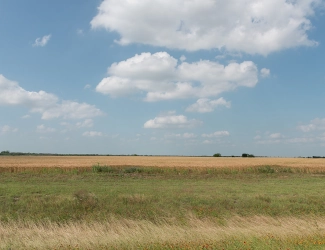
Where Did They Roam
It was not unusual for mammoth remains to be found in Texas. They lived during the Ice Age and roamed from Canada to Costa Rica through woodlands and fields such as those pictured above around Waco. As the dig continued since 1990, six additional animals were found through 1997. The dig continues inside the guided tour only dig shelter, where you can see the remains of the male, female, and two juveniles, still under excavation.
The original fossils, excavated up to 1990, are housed in the Strecker Museum, now the Mayborn Museum Complex, at Baylor University. That would make a nice second stop on your Waco Mammoth journey. Baylor University is located in Waco as well. There were more animals found within the years of the dig; a camel, a young saber-toothed cat, and other remains.
Photo above: Fields southeast of Waco, Texas, 2014, Carol M. Highsmith. Courtesy Library of Congress.

History of Waco
It had been homeland to the Wichita Indian tribe known as the Waco, but when settlers arrived around 1824, violence ensued until Stephen Austin made a treaty with them in 1825. The Waco would eventually move north toward Dallas, and by 1849, the first block of the city was designed and Shapley Ross built the first house. A bridge was built, used by some of the cattle herds that followed the Chisholm Trail, and the town grew rapidly. By 1870, there were three thousand and eight citizens.
By 1910, seen in the image above, there were twenty-six thousand four hundred and twenty-five. Today, the city is home to Baylor University, the Dr. Pepper Museum, Waco Mammoth, the Texas Ranger Hall of Fame, and the Texas Sports Hall of Fame. Population was estimated at north of 138,000 in 2020.
Photo above: A panoramic view of Waco, Texas in 1910, 1910, Haines Photo Co. Courtesy Library of Congress.

T-Shirts and Gifts from the official souvenirs of Americasbesthistory.com.
About
America's Best History where we take a look at the timeline of American History and the historic sites and national parks that hold that history within their lands.
Photos courtesy of the Library of Congress, National Archives, National Park Service, americasbesthistory.com and its licensors.
- Contact Us
- About
- © 2022 Americasbesthistory.com.
Template by w3layouts.


